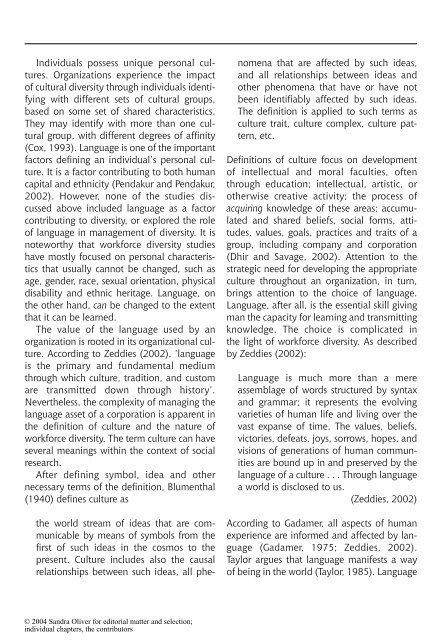Handbook of Corporate Communication and Public ... - Blogs Unpad
Handbook of Corporate Communication and Public ... - Blogs Unpad
Handbook of Corporate Communication and Public ... - Blogs Unpad
Create successful ePaper yourself
Turn your PDF publications into a flip-book with our unique Google optimized e-Paper software.
Individuals possess unique personal cultures.<br />
Organizations experience the impact<br />
<strong>of</strong> cultural diversity through individuals identifying<br />
with different sets <strong>of</strong> cultural groups,<br />
based on some set <strong>of</strong> shared characteristics.<br />
They may identify with more than one cultural<br />
group, with different degrees <strong>of</strong> affinity<br />
(Cox, 1993). Language is one <strong>of</strong> the important<br />
factors defining an individual’s personal culture.<br />
It is a factor contributing to both human<br />
capital <strong>and</strong> ethnicity (Pendakur <strong>and</strong> Pendakur,<br />
2002). However, none <strong>of</strong> the studies discussed<br />
above included language as a factor<br />
contributing to diversity, or explored the role<br />
<strong>of</strong> language in management <strong>of</strong> diversity. It is<br />
noteworthy that workforce diversity studies<br />
have mostly focused on personal characteristics<br />
that usually cannot be changed, such as<br />
age, gender, race, sexual orientation, physical<br />
disability <strong>and</strong> ethnic heritage. Language, on<br />
the other h<strong>and</strong>, can be changed to the extent<br />
that it can be learned.<br />
The value <strong>of</strong> the language used by an<br />
organization is rooted in its organizational culture.<br />
According to Zeddies (2002), ‘language<br />
is the primary <strong>and</strong> fundamental medium<br />
through which culture, tradition, <strong>and</strong> custom<br />
are transmitted down through history’.<br />
Nevertheless, the complexity <strong>of</strong> managing the<br />
language asset <strong>of</strong> a corporation is apparent in<br />
the definition <strong>of</strong> culture <strong>and</strong> the nature <strong>of</strong><br />
workforce diversity. The term culture can have<br />
several meanings within the context <strong>of</strong> social<br />
research.<br />
After defining symbol, idea <strong>and</strong> other<br />
necessary terms <strong>of</strong> the definition, Blumenthal<br />
(1940) defines culture as<br />
the world stream <strong>of</strong> ideas that are communicable<br />
by means <strong>of</strong> symbols from the<br />
first <strong>of</strong> such ideas in the cosmos to the<br />
present. Culture includes also the causal<br />
relationships between such ideas, all phenomena<br />
that are affected by such ideas,<br />
<strong>and</strong> all relationships between ideas <strong>and</strong><br />
other phenomena that have or have not<br />
been identifiably affected by such ideas.<br />
The definition is applied to such terms as<br />
culture trait, culture complex, culture pattern,<br />
etc.<br />
Definitions <strong>of</strong> culture focus on development<br />
<strong>of</strong> intellectual <strong>and</strong> moral faculties, <strong>of</strong>ten<br />
through education; intellectual, artistic, or<br />
otherwise creative activity; the process <strong>of</strong><br />
acquiring knowledge <strong>of</strong> these areas; accumulated<br />
<strong>and</strong> shared beliefs, social forms, attitudes,<br />
values, goals, practices <strong>and</strong> traits <strong>of</strong> a<br />
group, including company <strong>and</strong> corporation<br />
(Dhir <strong>and</strong> Savage, 2002). Attention to the<br />
strategic need for developing the appropriate<br />
culture throughout an organization, in turn,<br />
brings attention to the choice <strong>of</strong> language.<br />
Language, after all, is the essential skill giving<br />
man the capacity for learning <strong>and</strong> transmitting<br />
knowledge. The choice is complicated in<br />
the light <strong>of</strong> workforce diversity. As described<br />
by Zeddies (2002):<br />
Language is much more than a mere<br />
assemblage <strong>of</strong> words structured by syntax<br />
<strong>and</strong> grammar; it represents the evolving<br />
varieties <strong>of</strong> human life <strong>and</strong> living over the<br />
vast expanse <strong>of</strong> time. The values, beliefs,<br />
victories, defeats, joys, sorrows, hopes, <strong>and</strong><br />
visions <strong>of</strong> generations <strong>of</strong> human communities<br />
are bound up in <strong>and</strong> preserved by the<br />
language <strong>of</strong> a culture . . . Through language<br />
a world is disclosed to us.<br />
(Zeddies, 2002)<br />
According to Gadamer, all aspects <strong>of</strong> human<br />
experience are informed <strong>and</strong> affected by language<br />
(Gadamer, 1975; Zeddies, 2002).<br />
Taylor argues that language manifests a way<br />
<strong>of</strong> being in the world (Taylor, 1985). Language<br />
© 2004 S<strong>and</strong>ra Oliver for editorial matter <strong>and</strong> selection;<br />
individual chapters, the contributors

















